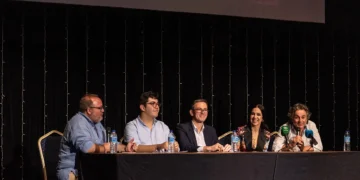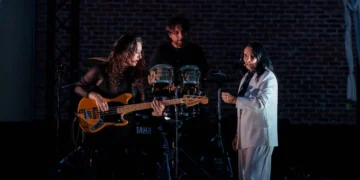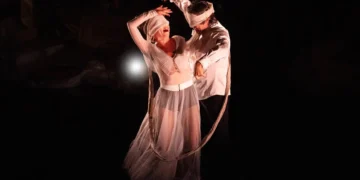|
|
||||||||
|
SPECIAL COVERAGE: BIENAL DE FLAMENCO DE SEVILLA 2010 “VAIVENES” Cía. Javier Barón Dance: Javier Barón, Carmelilla Montoya, Ana Morales, David Pérez, Antonio Molina “El Choro”. Cante: Miguel Ortega, José Valencia, David Palomar. Guitar: Javier Patino, Rafael Rodríguez. Cuban tres: Raúl Rodríguez. Violin: Alexis Lefévre. Percussion: José Carrasco. Artistic director: Javier Barón. The economic recession isn’t all bad news. Or at least I assume that some of the less contrived works we’re seeing this year from the biggest stars are the result of diminished resources. Javier Barón is one of the great flamenco dancers of our era. Discreet and taciturn, he doesn’t always receive due attention despite having received Spain’s highest dance award in 2008. The thing is, when other lesser artists may be adrift without the big financing they used to enjoy, this dancer has only to stand up, raise his arms (not too high, just a bit) and move to the compás of flamenco. It’s not that “Vaivenes”, the work which debuted last night at the Teatro Lope de Vega within the Bienal de Flamenco de Sevilla is a careless pastiche. On the contrary. There is excellent guitar and singing, novel ideas that work well, intelligence, effective lighting and staging, unexpected but welcome details… In other words, what flamenco ought to be (in my opinion), delving into what has been and continues to be in order to build upon a firm foundation. Between folklore, which is by definition static, and the avant-garde, nearly always ephemeral, exists this monumental genre of which artists like Javier Barón take such excellent advantage. End of speech, because the most important thing is the dancer’s new creation. It all begins with a standard fiesta finale that serves to declare that what we are about to see is flamenco flamenco, but in a different light. And Barón’s voyage has every possibility of reaching the most flamenco territory with a crew that includes singers José Valencia, Miguel Ortega and David Palomar, and the guitars of Rafael Rodríguez and Javier Patino. The pretext is no obstacle on this occasion. Alcalá de Guadaíra, a town famous for its bread and its soleares, the river, the area of Morón and Alcalá with the specific homegrown flavor of flamenco from the interior – all this feeds the imagination and creativity of Javier Barón who happens to be from Alcalá. With such a firm base, you can insert Alexis Lefévre with his violin and the Cuban tres of Raúl Rodríguez, diehard fan of Morón-style music, and it all acquires the most convincing flamenco aroma. Palomar recreates the text of a poem popularized by the Poeta de Alcalá (actually from Morón) in the declamatory style of years ago, sings, dances and manages to adapt his light-hearted Cádiz personality to the cause. There are fleeting audiovisuals which could have been developed a bit more, with fragments of film of Barón as a child, and images of the arid landscape. Dancer Carmelilla Montoya was another good idea recalling the heyday of the Familia Montoya, and she is even called upon to sing. Multifunctional artists are becoming quite the thing in this Bienal; Farruquito sang and played guitar in his work, and singers Miguel Ortega, Arcángel and Juan José Amador played guitar in others. A corps de ballet that included up-and-coming dancers like Ana Morales, David Pérez and Antonio Molina “Choro” was also a plus, Raúl Rodríguez is delightful with his guajira and his cute meandering around the stage, Rafael Rodríguez commits his accustomed devilish bits on guitar and recalls the era of Diego del Gastor, the entire company dresses up as bakers to form a carnival-style singing group, farruca to violin and tres, instruments that combine with the minor key to yield a certain middle-European sound, siguiriya as well as seguidilla (not at all the same thing!), saeta, alegrías, bulerías….a wealth of flamenco with few bumpy spots. But it is all eclipsed by Javier Barón’s soleá, restrained and elegant, saying more with less and dignifying the profession at every moment. “A TIEMPO” La Tremendita Text: Estela Zatania Cante: Rosario Tremendita. Guitar: Salvador Gutiérrez, Antonio Rey. Trumpet: Raynald Colom. Piano: José Reinoso. Double bass: Jordi Gaspar. Drums: Roger Blavia. Percussion: Paquito González. Palmas: El Oruco, Bobote. Guest artist: Rocío Molina. Chorus: El Tremendito, Naike Ponce, Gema Caballero. Rosario “La Tremendita” singing solea de Triana a capella. Thus begins this show titled “A Tiempo”, the same as the young singer’s recent recording. The Bienal is becoming a shopping center for the presentation of new products: paid promotion. I’d like it much more if singers would just come and sing. Imagine for a brief moment Manuel Agujeta saying, “…and now, a theme from my newest album”. Okay okay, it’s ludicrous, but the contrast is thought-provoking.
As you may have detected, Tremendita’s performance has left me in a bad mood. What began as a cante recital with frankly interesting contemporary touches, evolved into a session of jazz singing, lots of trumpet, drum solos, etc… Once again I got sucked in – they took advantage of my uncontrollable obsession with flamenco to pass off merchandise of another sort, and the audience’s reaction (effusive for the cante, tepid for the rest) says I wasn’t the only one. Make no mistake, along the way there were some interesting things. Granaína y media, very well-suited for Tremendita’s voice and delivery, polo to the compás of abandolao with the vocal lament carried out in harmony, a very sweet milonga…and Rocío. Rocío Molina. The Málaga dancer came to vent all the genius and dimension of her dance that only a few days ago she was determined not to reveal. In red velvet, dancing bulerías in profile face to face with the singer, it was like dying, going to heaven and being born again…several times. What a tidal wave of flamenco and art, and what communication between the two women. From that point on we were eased into piano bar mode. Tremendita, dressed as a nineteenth-century dandy with coat and tails of light blue satin, wielding a cane and seated on a stool, chatted with the audience, and the flamenco energy escaped like air from a pierced balloon despite the best efforts of guitarists Salvador Gutiérrez and Antonio Rey.
|
Descubre más desde Revista DeFlamenco.com
Suscríbete y recibe las últimas entradas en tu correo electrónico.



































